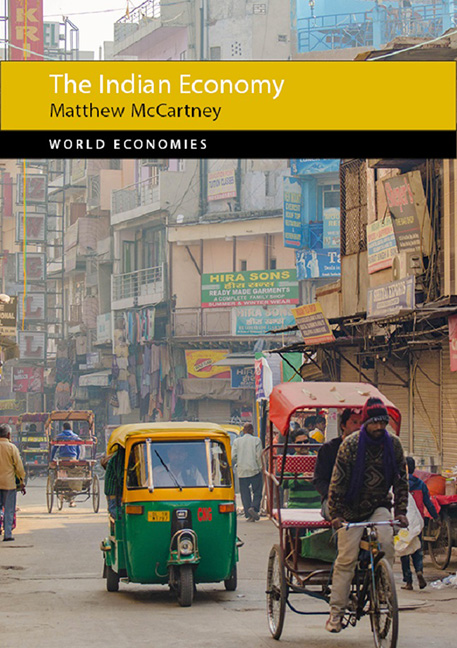Book contents
- Frontmatter
- Dedication
- Contents
- Acknowledgements
- List of Tables and Figures
- Maps
- 1 Introducing the Indian economy, 1947–2017
- 2 The Indian economic story since 1947
- 3 Measuring economic and human development
- 4 The form of the Indian economy
- 5 Human factors in the Indian economy
- 6 Making the Indian economy unique
- Conclusion: prospects for the Indian economy
- References
- Index
Conclusion: prospects for the Indian economy
Published online by Cambridge University Press: 09 August 2023
- Frontmatter
- Dedication
- Contents
- Acknowledgements
- List of Tables and Figures
- Maps
- 1 Introducing the Indian economy, 1947–2017
- 2 The Indian economic story since 1947
- 3 Measuring economic and human development
- 4 The form of the Indian economy
- 5 Human factors in the Indian economy
- 6 Making the Indian economy unique
- Conclusion: prospects for the Indian economy
- References
- Index
Summary
By 2017 India had a GDP per capita (adjusted for PPP) of almost $2,000 and had graduated to the status of a lower-middle-income nation. Although many people in India remained in poverty, India was no longer, officially a poor country. India could begin thinking of the next stage of its quest to become a developed country or, as many of its political leaders aspire, a Great Power. The quest would seem straightforward if India continues to grow at 7–8 per cent annually. But will it?
POST-2008 ECONOMIC SLOWDOWN
Growth has been sustained in recent years despite the lingering effects of the Global Financial Crisis of 2008. Annual growth averaged 7.7 per cent between 2008 and 2012, slowing to 4.6 per cent between 2012–14, but then gradually revived to 6.6 per cent in 2017. This slowdown was led by the manufacturing sector where growth slowed from 8 per cent to only 0.2 per cent, service-sector annual growth continued steadily at more than 6 per cent between 2008 and 2012 (Mohan & Kapur 2015: 3). Total investment declined modestly from 35.7 per cent of GDP between 2008–12 and 34.8 per cent between 2012–14. This was caused by a steady decline in private corporate sector investment, 11.6 to 9.2 per cent of GDP while public investment was steady, 8.7 to 8.1 per cent of GDP (ibid.: 6). In late 2016 Prime Minister Modi announced that the two largest notes in India (Rs500 and Rs1000) would cease to be legal tender from the next day. This demonetization was announced as a means of tackling the black economy, corruption and terrorism. It was assumed (wrongly) that black money was mainly held in cash and that black marketeers would find their black wealth and livelihoods lost. In practice almost 100 per cent of the existing notes in circulation were eventually exchanged in banks for newly printed notes. The sudden demonetization of over 85 per cent of India’s cash had a devastating impact on the predominantly cash-using informal economy. Small enterprises closed and workers went unpaid.
- Type
- Chapter
- Information
- The Indian Economy , pp. 233 - 240Publisher: Agenda PublishingPrint publication year: 2019



